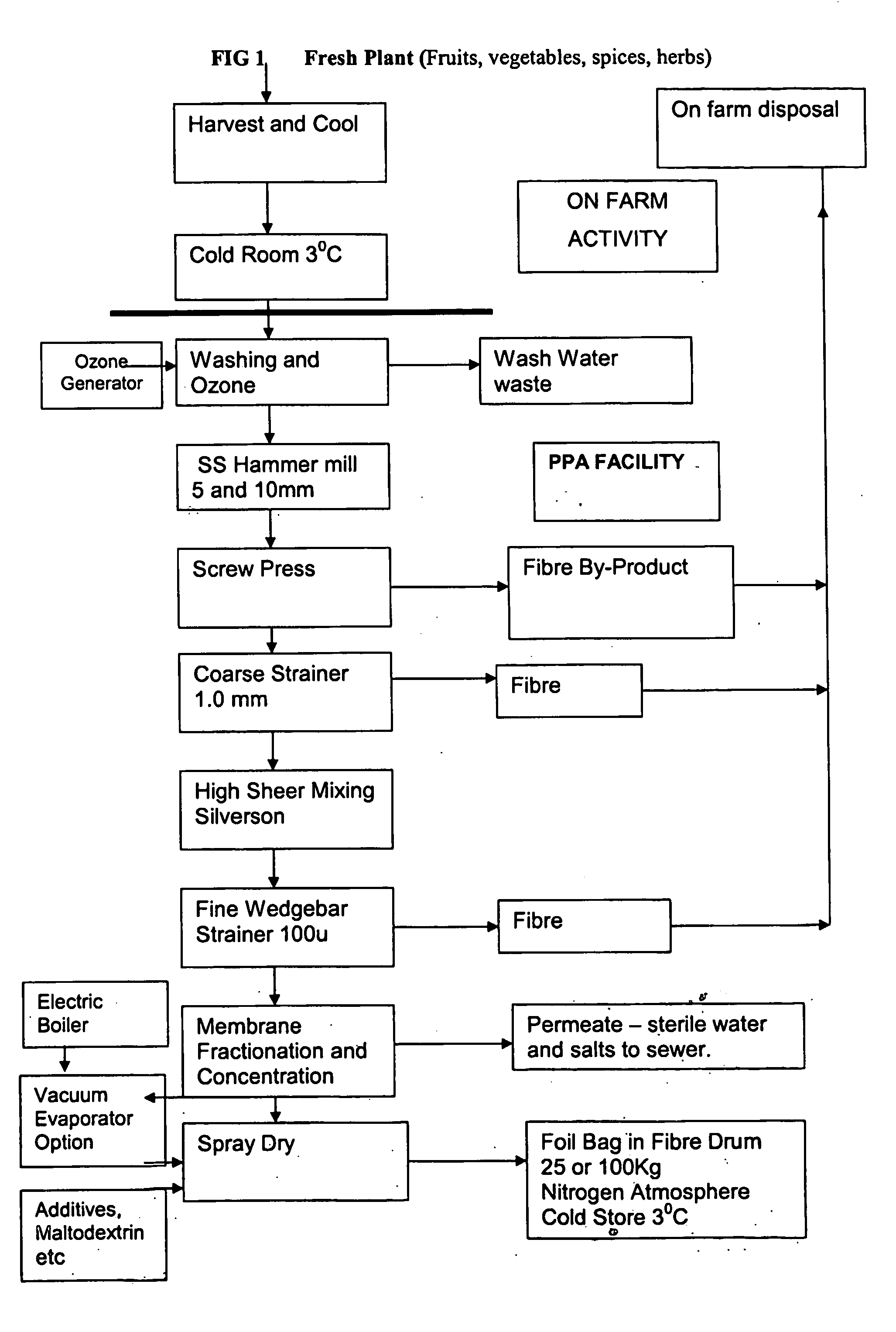Process and apparatus for modifying plant extracts
a technology of plant extracts and processing equipment, which is applied in the directions of magnoliophyta medical ingredients, plant ingredients, biocide, etc., can solve the problems of large quantity of plant material, plant deterioration, and low level of phytochemicals in plants
- Summary
- Abstract
- Description
- Claims
- Application Information
AI Technical Summary
Benefits of technology
Problems solved by technology
Method used
Image
Examples
specific example 1
Chilli
[0152] A crop of cayenne chilli was harvested and delivered to the processing facility within one hour.
[0153] 100 kg of chilli was washed with high pressure water and then submerged in a wash bath containing water at 20 degrees celsius with dissolved ozone at a concentration of 5 mg per litre. The chilli was drained and then milled in a stainless steel hammer mill.
[0154] The milled material passed into a screw press and the juice was extracted. Large solids 1-2 mm were removed in a wedge bar strainer with a clearance of I The juice was pumped to a 100 litre tank and blended with high sheer using a Silverson mixer. The blended juice was then passed through a fine wedge bar strainer with a clearance of 100 microns.
[0155] The juice was then pumped at high pressure (2500 Kpa) through a nanofiltration spiral wound membrane cartridge. The membrane was a spiral wound nanofiltration cartridge from Osmonics U.S.A. with a nominal pore size of 10 angstroms. (10 000 angstroms=1 micron...
specific example 2
Solvent Extraction of Chilli
[0159] The spray dried powder from Example 1 was extracted by solvent extraction in a small stirred tank reactor. The solvent used was acetone.
[0160] The acetone was removed from the extract by vacuum evaporation to produce an oleo resin. This oleo resin was extracted in a small stirred tank reactor. The solvent used in this stage was ethanol. The ethanol was removed from the extract by vacuum distillation to yield a second, more refined, oleo resin with high levels of capsaicin.
[0161] This oleo resin can be used at a 10% concentration in pressure sprays for personal protection, riot control and disarming criminals. The oleoresin can also be used as concentrated chilli flavour in foods.
[0162] The oleo resin from this stage can be further refined by using a liquid / liquid supercritical fluid extraction using CO2.
[0163] The oleo resin was pumped into near the top of the small stainless steel SCF column. Supercritical carbon dioxide was pumped in near th...
specific example 3
Red Grapes
[0172] A fresh supply of red grapes was purchased and washed in a commercial Tipax washer manufactured by Tripax Engineering, Victoria Australia. The product is drawn down deep into the tank by means of a vortex created by angled underwater jets. The washed grapes spill over to a dewatering vibrator and up a conveyor into the hammermill and then into a screw press.
[0173] Red juice is extracted solids are retained by a 0.7 mm screen.
[0174] The juice is subjected to high sheer in a Silverson mixer and then passed through a 100 micron strainer to a nanofiltration membrane plant fitter with a nanofiltration spiral wound cartridge. The membrane is operated with a transmembrane pressure of 2,500 KPa. A clear permeate passed from the membrane and a dark red retentate was produced rich in grape polyphenols.
[0175] A small quantity of malto dextrin was blended with the red juice and the concentrate was spray dried using a Niro spray drier. A rich red brown powder was produced. c...
PUM
 Login to View More
Login to View More Abstract
Description
Claims
Application Information
 Login to View More
Login to View More - R&D
- Intellectual Property
- Life Sciences
- Materials
- Tech Scout
- Unparalleled Data Quality
- Higher Quality Content
- 60% Fewer Hallucinations
Browse by: Latest US Patents, China's latest patents, Technical Efficacy Thesaurus, Application Domain, Technology Topic, Popular Technical Reports.
© 2025 PatSnap. All rights reserved.Legal|Privacy policy|Modern Slavery Act Transparency Statement|Sitemap|About US| Contact US: help@patsnap.com

